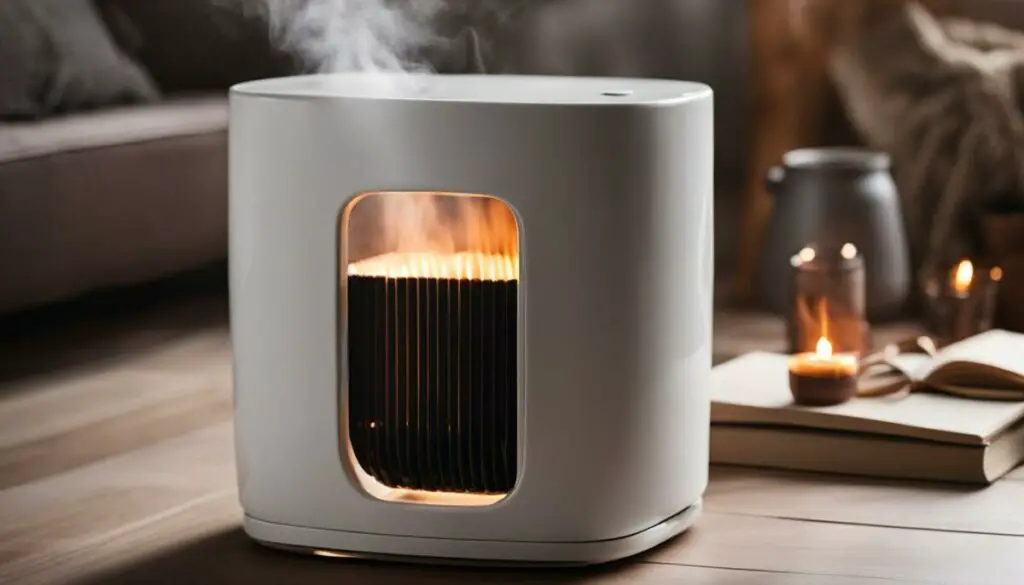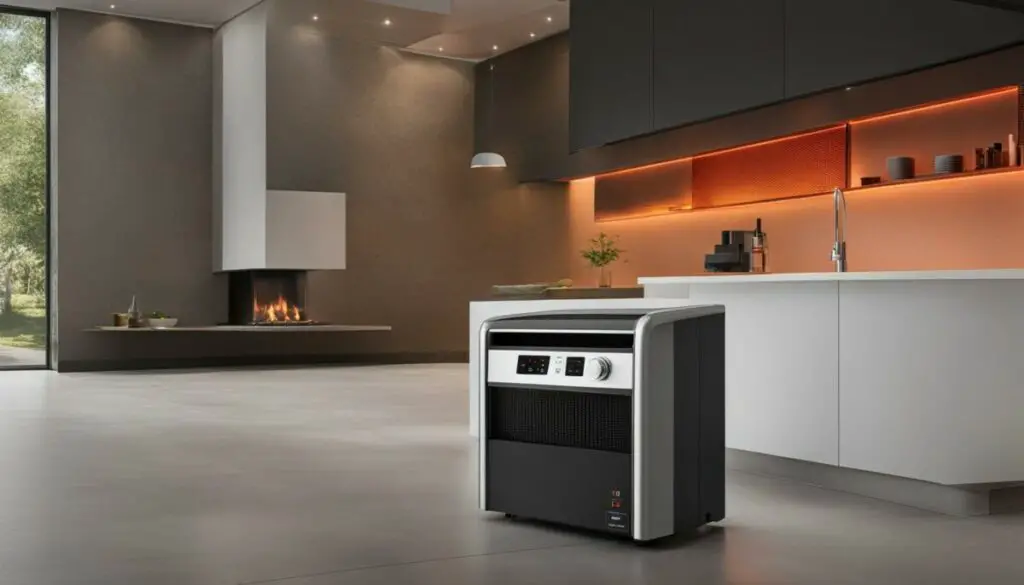Last Updated on 5 months by Francis
When it comes to heating your home or office, there are several options to choose from. Two of the most popular choices in the US are ceramic and infrared heaters. Both offer unique features and benefits, making it difficult to decide which one is the best fit for your heating needs.
In this article, we will explore the question of whether ceramic or infrared heaters are better. We will compare their features, benefits, and differences to help you make an informed decision when choosing between these two heating options.
Contents
Key Takeaways:
- Choosing between ceramic and infrared heaters can be a difficult decision.
- Both options offer unique features and benefits.
- The best choice for you depends on your specific heating needs and preferences.
- We will compare their features, benefits, and differences to help you make an informed decision.
- Read on to discover which one is the best fit for your heating needs.
Advantages of Ceramic Heater

When it comes to choosing a heater for your indoor space, ceramic heaters are a popular option due to their many benefits. Here are some advantages of ceramic heaters:
- Heating Capabilities: Ceramic heaters are known for their ability to provide consistent heat, making them ideal for use in small to medium-sized rooms.
- Energy Efficiency: Ceramic heaters use less energy compared to other electric heaters, making them a cost-effective option for heating your home.
- Safety Features: Ceramic heaters have safety features such as overheat protection and tip-over switches, which make them a safer option for homes with children or pets.
- Quiet Operation: Ceramic heaters operate quietly, making them great for use in bedrooms or other quiet environments.
- Portability: Ceramic heaters are compact and lightweight, making them easy to move from room to room as needed.
- Design: Ceramic heaters come in various designs and styles that can complement your home’s decor, adding both warmth and aesthetic appeal.
With these advantages, it is no surprise that ceramic heaters are a popular choice for many homeowners.
Advantages of Infrared Heater

Infrared heaters are a popular choice for many reasons, including their efficiency, instant warmth, and more. Let’s explore their advantages in further detail.
1. Direct Heat
The most significant advantage of infrared heaters is that they provide direct heat, warming up objects and people instead of the air in the room. This means that you can feel the effects of the heater almost immediately.
2. Energy Efficiency
Another benefit of infrared heaters is their energy efficiency. They do not heat the entire room; instead, they focus on heating specific areas, making them more effective in conserving energy. This also makes them ideal for use in large, drafty spaces.
3. Low Maintenance
Since infrared heaters have fewer parts than ceramic heaters, they require less maintenance and are less likely to break down. They also have a longer lifespan.
4. Safety Features
Infrared heaters come with safety features such as tip-over switches and overheat protection, ensuring that they are safe to use in any environment.
“The most significant advantage of infrared heaters is that they provide direct heat, warming up objects and people instead of the air in the room.”
As you can see, infrared heaters offer many advantages over ceramic heaters. They are efficient, low maintenance, and provide direct heat, making them an excellent choice for anyone looking to save money on their heating bills or warm up specific areas in their home or office.
Ceramic Heater vs Infrared Heater Comparison

When it comes to choosing a heater, the decision often boils down to ceramic vs infrared technology. Here, we provide a comprehensive comparison of both heating technologies to help you make an informed decision.
Heating Methods
Ceramic heaters work by passing electricity through ceramic plates, which then heat up and radiate heat into the room. In contrast, infrared heaters emit infrared radiation, which travels through the air and heats objects directly.
While both methods are effective in providing warmth, infrared heaters are typically better suited for targeted heating of specific areas, while ceramic heaters are better suited for heating larger spaces.
Temperature Control
Both ceramic and infrared heaters have temperature control features, but infrared heaters are generally better at providing precise heating control. This is because they have advanced thermostats that can detect and adjust to even the slightest temperature changes.
Ceramic heaters, on the other hand, typically have a basic thermostat that may not be as accurate in maintaining a consistent temperature.
Portability
Both types of heaters are generally lightweight and can be easily moved from one room to another. However, ceramic heaters tend to be bulkier and have a larger footprint, while infrared heaters are generally more compact and take up less space.
Maintenance Requirements
Ceramic heaters require minimal maintenance, as they do not have any filters that need to be replaced or cleaned. In contrast, infrared heaters typically have a filter that needs to be cleaned periodically to ensure optimal performance.
Table: Ceramic Heater vs Infrared Heater Comparison
| Comparison Factor | Ceramic Heater | Infrared Heater |
|---|---|---|
| Heating Methods | Passes electricity through ceramic plates to radiate heat into the room | Emits infrared radiation that heats objects directly |
| Temperature Control | Basic thermostat | Advanced thermostat for precise control |
| Portability | Bulkier and larger footprint | Compact and takes up less space |
| Maintenance requirements | Minimal maintenance, no filters to replace or clean | Filter needs to be cleaned periodically for optimal performance |
Please note that the above comparison metrics are general guidelines and may vary depending on the specific make and model of the heater.
Overall, when choosing between ceramic and infrared heaters, it’s important to consider factors such as room size, heating requirements, and personal preferences. With this comparison, you can weigh the pros and cons of each option to make an informed decision.
Energy Efficiency: Ceramic Heater vs Infrared Heater

When it comes to choosing a heater, energy efficiency is a crucial factor to consider. So, which is more energy-efficient, ceramic or infrared heaters?
Let’s take a closer look.
First, it’s important to understand that both ceramic and infrared heaters are designed to be energy-efficient. However, they achieve this in different ways.
| Ceramic Heater | Infrared Heater |
|---|---|
| Ceramic heaters use electricity to heat up ceramic plates, which then radiate heat into the room. They are designed to provide consistent heat, so they don’t need to run continuously. Ceramic heaters are energy-efficient because they can warm up a room quickly and maintain the temperature with minimal power consumption. | Infrared heaters use infrared radiation to heat up objects and people directly, rather than the air in the room. This makes them a more efficient heating option for small spaces, as they don’t waste energy heating up unused air. Infrared heaters can also provide instant warmth, so you don’t need to keep them running for long periods. |
So, which one is more energy-efficient? It depends on your specific heating needs. If you’re looking for an energy-efficient heating option for a small space, an infrared heater might be the best choice. However, if you need to heat up a larger room, a ceramic heater may be more suitable.
It’s also worth noting that both ceramic and infrared heaters are designed to be energy-efficient, so you can’t go wrong with either one. Ultimately, it comes down to your personal preference and heating requirements.
Pros and Cons of Ceramic Heaters

Ceramic heaters are a popular choice for heating indoor spaces due to their many advantages. However, like any heating option, they also have some limitations to consider. Here’s a breakdown of the pros and cons of ceramic heaters:
Pros of Ceramic Heaters
- Consistent heat: Ceramic heaters provide a steady, even heat that can quickly warm up a room and maintain a comfortable temperature.
- Safety features: Ceramic heaters are designed with safety features such as overheat protection and cool-to-the-touch exteriors, making them a safe option for households with children or pets.
- Quiet operation: Ceramic heaters operate quietly, making them a good option for bedrooms, offices, and other quiet spaces.
- Energy-efficient: Ceramic heaters use less energy than other types of heaters, such as electric or gas heaters, making them a cost-effective option for heating smaller spaces.
- Portable: Ceramic heaters are lightweight and easy to move around, allowing you to heat different areas of your home as needed.
Cons of Ceramic Heaters
- Slower heating time: Ceramic heaters may take longer to heat up larger spaces, so they may not be the best option for heating large rooms or open areas.
- Limited heat distribution: Ceramic heaters tend to radiate heat in one direction, so they may not be the best option for heating areas with multiple people or objects.
- Requires maintenance: Ceramic heaters require periodic maintenance such as cleaning the filter and ensuring the unit is free of dust and debris.
As you can see, ceramic heaters have several advantages and disadvantages to consider. However, with proper use and maintenance, they can be a safe, effective, and energy-efficient heating option for your home.
Pros and Cons of Infrared Heaters

Infrared heaters offer many benefits, such as their ability to heat objects directly, providing instant warmth, and operating quietly. However, they also have some limitations that you should consider before making a purchase decision.
Pros of Infrared Heaters
Direct Heating: Infrared heaters work by emitting infrared radiation that directly heats objects and people in the room, rather than heating the air. This makes them an efficient and effective way of providing warmth in a specific area.
Instant Warmth: Infrared heaters provide instant warmth because they operate through radiation, rather than heating the air. This makes them a popular choice for people looking to warm up quickly.
Quiet Operation: Infrared heaters operate silently, making them an excellent option for people who prefer a noise-free environment.
Cons of Infrared Heaters
Limited Heat Distribution: Infrared heaters are effective at heating objects in close proximity to them, but their heat does not spread far beyond that. This means that they are not ideal for heating larger areas or whole rooms.
Higher Cost: Infrared heaters tend to be more expensive than other types of heaters, such as ceramic heaters. This higher cost may be a factor when considering your budget.
More Maintenance: Infrared heaters require more maintenance than other types of heaters since their heating elements may accumulate dust and other debris, affecting their efficiency over time.
Overall, infrared heaters are a great heating option for specific areas, providing instant and efficient warmth. However, their limited heat distribution and higher cost could be a barrier for some users. Consider your heating requirements and preferences carefully when choosing between an infrared heater and other types of heaters, such as ceramic heaters, as discussed in other sections of this article.
Choosing Between Ceramic and Infrared Heaters

When it comes to choosing between ceramic and infrared heaters, there are several key factors to consider. The decision ultimately depends on your heating needs and preferences.
Room Size
The size of the room you intend to heat is a crucial factor in deciding between ceramic and infrared heaters. Infrared heaters are ideal for smaller rooms as they provide direct warmth to people and objects in their line of sight. Ceramic heaters, on the other hand, are more effective in heating larger spaces, such as living rooms or bedrooms, where heat distribution is essential.
Heating Requirements
The type of heating you require is another factor to consider. If you need a heater for instant warmth, infrared heaters are an excellent choice. However, if you want a heater to maintain a consistent temperature throughout the day, a ceramic heater is a better option.
Safety Concerns
Safety is a top priority when it comes to choosing a heater. Ceramic heaters have several safety features, including automatic shut-off, tip-over protection, and overheat protection, making them a safe choice for households with children or pets. Infrared heaters do not get hot enough to cause fires, but they still pose a burn risk if touched while in use.
Personal Preferences
Personal preferences play a significant role in choosing between ceramic and infrared heaters. If you prefer a heater that is portable and easy to move from room to room, ceramic heaters are a better choice. However, if you want a heater that emits little to no noise, an infrared heater is a better fit.
Ultimately, the decision to choose between ceramic and infrared heaters boils down to your specific needs and preferences. Consider the factors outlined in this section, and weigh the pros and cons of each type to make an informed decision.
Key Considerations for Choosing a Heater
When deciding between ceramic and infrared heaters, several factors should be considered to make an informed decision. Below are the key considerations:
Room Size
The size of the room you intend to heat should be a vital factor when considering a ceramic or infrared heater. Ceramic heaters are suitable for small to medium-sized rooms while infrared heaters can heat large rooms or specific areas. Consider the dimensions of the room and ensure that the heater you choose can effectively heat the area.
Heating Requirements
Your heating requirements should also be taken into account when choosing between ceramic and infrared heaters. If you need to heat the room quickly, infrared heaters are a good option because they provide immediate warmth. However, if you require a consistent heat source, ceramic heaters are the better option since they distribute heat evenly throughout the room.
Safety Concerns
If you have children or pets, safety should be a priority when choosing a heater. Ceramic heaters have safety features such as automatic shut off in case of overheating or tipping over, making them a safe choice. Infrared heaters also have safety features, but they emit high heat, which can cause burns if handled inappropriately, making them risky around young children or pets.
Pros and Cons of Ceramic and Infrared Heaters
| Ceramic Heater | Infrared Heater | |
|---|---|---|
| Pros |
|
|
| Cons |
|
|
Personal Preferences
Personal preferences, such as design, noise level, and ease of use, should also be considered when choosing between ceramic and infrared heaters. Ceramic heaters come in various designs and colors, and some models are noiseless, making them ideal for use in a bedroom while sleeping. In contrast, infrared heaters are quieter and easy to install and operate, making them suitable for use in an office or living room.
By considering the above factors, you can make an informed decision when choosing between ceramic and infrared heaters.
Conclusion
When it comes to choosing between ceramic and infrared heaters, there is no clear winner as both have their advantages and disadvantages. The decision ultimately comes down to your personal preferences and specific heating needs.
Those looking for a heater with consistent heat and safety features may prefer a ceramic heater, while those seeking instant warmth and direct heating may opt for an infrared heater.
When choosing between the two, consider factors such as the size of the room you need to heat, your energy-saving goals, and safety concerns.
Overall, both ceramic and infrared heaters can provide an effective heating solution for your home or office. We hope this article has provided you with valuable insights into the differences between ceramic and infrared heaters, and has helped you make an informed decision based on your specific needs.
Thank you for reading, and stay warm!
FAQ
Is ceramic or infrared heater better?
Both ceramic and infrared heaters have their own advantages and disadvantages. The best choice for you depends on your specific heating needs and preferences.
What are the advantages of ceramic heaters?
Ceramic heaters offer efficient heating capabilities, energy efficiency, and safety features that make them a popular choice for heating indoor spaces.
What are the advantages of infrared heaters?
Infrared heaters provide instant warmth, energy efficiency, and the ability to heat objects directly, making them a preferred option for heating specific areas.
How do ceramic heaters and infrared heaters compare?
Ceramic heaters and infrared heaters differ in terms of their heating methods, temperature control, portability, maintenance requirements, and other factors, which can help you decide which one is the best fit for your heating needs.
Which is more energy-efficient, ceramic or infrared heater?
The energy efficiency of ceramic heaters and infrared heaters depends on factors such as power consumption, heat distribution, and overall effectiveness in conserving energy. It’s important to choose a heater that is both effective and energy-efficient.
What are the pros and cons of ceramic heaters?
Ceramic heaters offer advantages such as consistent heat and safety features, but they may have limitations such as slower heating times in larger spaces.
What are the pros and cons of infrared heaters?
Infrared heaters provide benefits like heating objects directly and instant warmth, but they may have drawbacks such as limited heat distribution in larger areas.
How do I choose between ceramic and infrared heaters?
When choosing between ceramic and infrared heaters, consider factors such as room size, heating requirements, safety concerns, and personal preferences to make an informed decision that suits your specific needs.
What are the key considerations for choosing a heater?
The key considerations when choosing between ceramic and infrared heaters include factors discussed in the previous sections, such as heating technology comparison, pros and cons, and your specific requirements.
Is ceramic or infrared heater better for me?
The best choice between ceramic and infrared heaters depends on your specific heating needs and preferences. We recommend considering the factors discussed in this article to make an informed decision.


.jpg)





